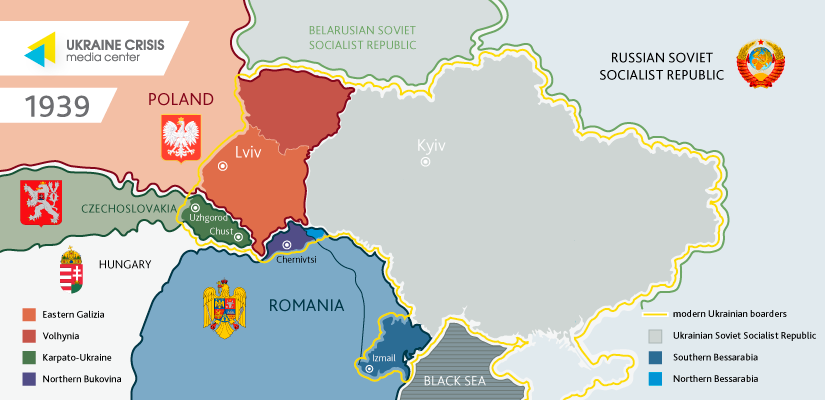You can trace almost all the history of World War II in the south of Eastern Europe, answering one single question: when did World War II begin on the territory of Ukraine? The answer to this question is not simple since in the beginning of 1939 all the lands belonging to Ukraine today were divided among four states – the Soviet Union, Poland, Romania and Czechoslovakia – and the peoples of each of them passed through their own difficult period of self-determination and troubled relationship with neighbors.
Czechoslovakia – March 14, 1939
For a part of Ukrainians, the war had begun almost half a year before it became known as the world war. However, not directly with Hitler’s Germany, but with its ally Hungary.
After the World War I, a region called the Podkarpatska Rus (modern Zakarpattia region) became part of Czechoslovakia. On October 8, 1938, it received autonomy in already federal Czechoslovakia. The population of the newly formed Carpathian Ukraine was about 725, 000. Among the Ukrainian majority (Rusyns), Jews and other nationalities, almost 16 percent of the autonomy population were Hungarians. On the night of March 13-March 14, 1939, the autonomous Carpathian Ukraine was attacked by Hungary. Germany declared its support for Hungary during the First Vienna Arbitration on November 2, 1938, according to which Hungary was supposed to receive parts of Czechoslovakia with the “vast majority of the Hungarian population”. On March 16, after bloody battles, the Hungarian troops captured the capital of the Carpathian Ukraine Khust, and in late March, the president and a part of the government left the country, which thus ceased to exist. Almost simultaneously, on March 15, the German troops occupied other regions of Czechoslovakia.
Over the next two years, Hungary continued to receive German support for the annexation of neighboring states, and since 1940, having entered into a treaty of three forces, participated in World War II on the German side. On June 27, 1941, Hungary declared war on the Soviet Union.
Poland – September 1, 1939
From 1921, according to the Polish-Soviet Treaty of Riga, parts of Eastern Galicia (modern Lviv, Ivano-Frankivsk regions and part of Ternopil region), Volyn (modern Volyn and Rivne regions, part of Zhytomyr, Ternopil and Khmelnytsky regions) and Polissia (part of modern Belarus) belonged to Poland. These territories were inhabited mostly by Ukrainians and Belarusians.
On August 23, 1939, Hitler and Stalin signed the Molotov-Ribbentrop Pact and the secret Annex to it, which divided Eastern Europe. Thereafter, Germany invaded Poland on September 1. On this very day, with an air attack conducted by the Wehrmacht, the Second World War began also for the citizens of Lviv. On September 17, under the pretext of protecting ethnic Ukrainians and Belarusians, but in fact, using agreements with Hitler, the Soviet troops crossed the eastern border of Poland. In a few days, they occupied all the territories of modern western Ukraine. Eastern Galicia and Volyn were transferred to the Ukrainian SSR, and Polissia, inhabited mostly by Belarussians – to the Byelorussian SSR.
Romania – July 26, 1940
The war to Carpathian Ukraine was brought by German’s ally Hungary, whereas Bessarabia (now Moldova and parts of Chernivtsi and Odesa regions) and Northern Bukovina (part of modern Chernivtsi region), which then belonged to Romania, were captured by the Soviet Union that at that time was considered to be a partner of Germany under the Molotov-Ribbentrop Pact.
On July 26, 1940, Romania yielded the terms of an ultimatum issued to it by the Soviet Union in order to avoid a bloody and hopeless confrontation. Its allies, France and Britain, could not protect it at that time: Britain left the continent after the Battle of Dunkirk two months earlier, and France capitulated to Germany on June 22, 1940. In early August 1940, the northern and southern parts of Bessarabia, as well as Northern Bukovina inhabited mostly by Ukrainians, were transferred to the Ukrainian SSR, while the central part of Bessarabia formed the Moldavian SSR.
In autumn of 1940, Romania, together with Germany, began to prepare for a war with the Soviet Union. German and two Romanian armies attacked Bukovina and Bessarabia on July 2, 1941, 10 days after Germany began the war with the Soviet Union.
Soviet Ukraine – June 22, 1941
Hitler, who was in a state of war with Britain, needed to seize the resources of the USSR as soon as possible. In December of 1940, he began planning Operation Barbarossa. The invasion of the German troops took place on the morning of June 22, 1941, along the frontline stretching from the Baltic to the Black Sea. More than four thousand aircraft supported the invasion. Most of the Soviet military aircraft were destroyed at aerodromes. Kyiv residents also suffered from the air attack. Germany outclassed the Soviet Union in terms of military assets and personnel. The Molotov-Ribbentrop Pact appeared to be a trap: Stalin sent his troops westward of a well-fortified defense line, to defend new, unfortified borders. The Soviet troops retreated quickly. Kyiv was seized three months later, on September 19, 1941. By the end of the year, after bloody battles, almost entire Ukraine was occupied by Germany.
Printed sources used:
Serhii Plokhy: The Gates of Europe: A History of Ukraine, New York: Basic Books, A Member of the Perseus Books Group, 2015

